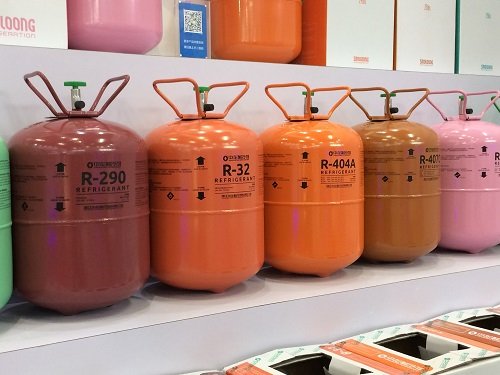Ammonia - NH3 (R717)
According to its thermodynamic properties is one of the best refrigerants. Widely used in compression (mainly in reciprocating and screw) chillers and absorption chillers. These chillers are used in the food industry, ldozavodah, artificial ice rinks, large refrigerators, on fishing trawlers, etc. Required for the operation of skilled staff. It is a colorless gas with a suffocating odor. It is lighter than air, is toxic. Causes irritation of the mucous membranes and upper respiratory tract. Permissible concentration in the air - not more than 0.02 mg / L, the content in an amount of 0.5-1% can be fatal. Fire and explosion hazard. Lights when the concentration in the air for more than 11%, explodes when the content 16-26,8% (especially dangerous ammonia at 22%). Ammonia is highly soluble in water (700 volumes of NH3 vapor in 1 volume of H2O - ammonia). In oil dissolves a little, does not change its viscosity. In the discharge line separators are required. No effect on ferrous metals, aluminum. In the presence of water destroys zinc, copper and their alloys (except phosphor bronze). At higher heat transfer coefficient of ammonia (almost like water), which allows you to use as a heat transfer element is usually water tubes without fins. Great value of the adiabatic index (k = 1,31) leads to high discharge temperature of the compressor. It is advisable to water-cooled compressors. It is necessary to avoid overheating of ammonia vapor in the suction line. Ammonia is relatively cheap, chemically stable, is widespread. Applies wherever toxic and explosive are not determining factors.
Freons (Chlorofluorocarbon)

It is a colorless gas, odorless, about 4 times heavier than air, harmless. Fire-hazardous, but when in contact with open flames CFCs is their decomposition with the formation of some poisonous gas phosgene. Therefore, it is forbidden to smoke, use open fire in areas where there is a freon installation. CFCs, in the majority, very fluid, practically insoluble in water, readily dissolve oil that facilitates the organization of compressor lubricants. They are organic solvents, so simple is not suitable for rubber gaskets. PTFE is used, petrol-resistant rubber - sevanite or paronit - material from asbestos, rubber and fillers. The majority of refrigerants specific mass substantially lower cooling capacity than ammonia. This means that the size and weight of compressor units, in freon piping installations considerably higher than ammonia (for the same refrigerating capacity). But it gives some advantages: a) small (household) refrigerators it allows the use of compressors with acceptable efficiency, more reliably regulate holodoproivoditelnost; b) in large refrigeration units have the ability to quickly jump to mnogostupe- chatym centrifugal compressor that offers significant advantages. Significant lack of freon - low heat transfer coefficients during boiling and condensation. This requires a large heat transfer surfaces. Therefore, freon heat exchangers typically use the finned heat exchanger tubes. And as freons neutral to all metals, they are usually made of copper alloy. However, each refrigerant has its own peculiarities which must be considered when selecting the working fluid for refrigeration equipment.
The principle of selection of refrigerants
In economic terms, it is desirable that the refrigerant had characteristics that would ensure the minimum energy consumption per unit of capacity. However, an analysis of all the properties of the refrigerant and experience has shown that the power consumption per unit cooling capacity is almost the same for all common refrigerants. Therefore, the efficiency and cost-effectiveness are not generally the decisive factors in the choice of refrigerant. More important are the properties that allow you to reduce weight, size and the initial cost of refrigeration, automation and simplify maintenance.
An essential factor - the cost and availability of the refrigerant safety requirements.
